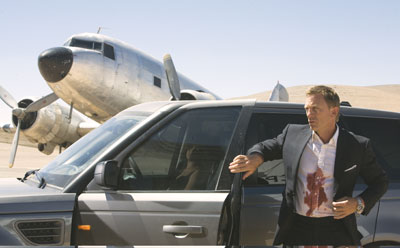
News
Alternate Approach: Live and let fly
Hello New York, your Pan Am 323 just landed, Kingston, Jamaica,” confirms an air traffic controller as the Pan American Boeing 707 gracefully sped along a runway for the 1962 film Dr. No, James Bond’s first cinematic outing that would launch a $5 billion film franchise.
October 31, 2012 By David Carr
Hello New York, your Pan Am 323 just landed, Kingston, Jamaica,” confirms an air traffic controller as the Pan American Boeing 707 gracefully sped along a runway for the 1962 film Dr. No, James Bond’s first cinematic outing that would launch a $5 billion film franchise. The sequence was repeated in the sequel, From Russia with Love, again with a Pan Am aircraft (clearly early Bond’s airline of choice), this time in Istanbul.
 |
|
| With missions to faraway exotic destinations, 007 fed into the jet-set culture, and vice versa. PHOTO: MGM
|
Aviation has played recurring roles in the Bond movies, either as part of the supporting cast in airport scenes and air-to-air footage, or delivering the thrills. The latter was the case with “Little Nellie,”the heavily armed, rocket launching and machine gun firing Wallis WA-116 autogyro (named after its creator, Ken Wallis, a retired Royal Air Force Second World War pilot) that Sean Connery flew in aerial combat against four SPECTRE helicopters in You Only Live Twice (1967). “Four big shots made improper advances toward her, but she defended her honour with great success,” Connery says. High on the thrills list was also the TRS-18 microturbo-powered Bede microjet that Roger Moore manoeuvred to escape Cuba in the opening sequence for Octopussy (1983).
This year marks the 60th anniversary of air travel by jet, but the jet age did not kick in until the very early 1960s, around the time of the first Bond release. With missions to faraway exotic destinations, 007 fed into the jet-set culture, and vice versa. The producers built on the fantasy with stunningly beautiful women, sophisticated gadgets, flashy sportscars (coming perilously close to ‘jumping the shark’ with an imagination-stretching invisible car in the 2002 film Die Another Day) and plenty of airplanes.
Guy Hamilton, director of Goldfinger (1964), describes the Bond film culture in the October 2012 issue of Vanity Fair. “Don’t take a train when you can take a plane, and if you are going to take a plane, take the newest one.” And Hamilton did, transporting Bond to Kentucky aboard Auric Goldfinger’s large and thirsty, four-engined Lockheed L329 JetStar, piloted by Pussy Galore, and giving most of the audience their first glimpse of the world’s first executive jet. The audience watched another rarity, Pussy Galore’s Flying Circus, using five formation flying Piper Cherokee PA-28s, intended to release nerve gas over Fort Knox. Piper delivered the first PA-28 in 1960, and according to Air & Space magazine, the appearance in Goldfinger was an early example of product placement.
Bond flies in the Space Shuttle two years before Columbia left the launch pad on its maiden voyage in Moonraker (1979), goes underwater to locate two NATO atomic bombs loaded onto a hijacked Avro Vulcan in Thunderball (1965) – after making a quick getaway in a Bell Aerosystems Rocket Belt in the same film – smuggles a rogue Russian general out of the Soviet Union in a British Aerospace Harrier T.10 in Living Daylights (1987) and rips the wings off a single-engine Cessna trainer during an airside chase scene in Live and Let Die (1973). “Let’s just wing it shall we, Mrs. Bell?” our hero exclaims.
Air & Space magazine used the 2008 premiere of Quantum of Solace (featuring a black SIAI-Marchetti SF.260TP aerobatic and military trainer) to ask pilots to rate the performance of several of the higher-profile aircraft in the James Bond pictures – which ones were “Bond Cool.” The “Little Nellie” Autogyro and Acrostar Micro-jet both scored big, while the JetStar and Rocket Belt fell slightly short of the mark despite the novelty, proving everything is subjective.
This column went to press before the November premiere of Skyfall, the 23rd film in the James Bond franchise. As such, the inevitable aircraft and aviation scenes remain a tightly wrapped secret, although the trailer has given up a couple of clues including helicopters and what appears to be a sword fight inside an airplane cabin.
Finally, in Devil May Care, the 2008 James Bond novel published to commemorate Ian Fleming’s 100th birthday, British author Sebastian Faulks picks up at the height of the Cold War where 007’s creator left off before his death in 1964. In the book, Bond foils a plot by a power-crazed pharmaceutical magnate to crash a stolen Vickers VC10 commercial jet into a Soviet nuclear factory, thereby forcing a retaliatory attack on Great Britain. Every inch as sleek and elegant as the Lockheed Constellation that came before her, Britain’s last long range jetliner also celebrates its 50th anniversary in 2012, and has long been this correspondent’s favourite airplane. Should 007’s film producers ever consider a retro-Bond, Devil May Care should be its first pick. The worthy VC10 is long overdue for its cinematic close-up.
David Carr is a Wings writer and columnist.